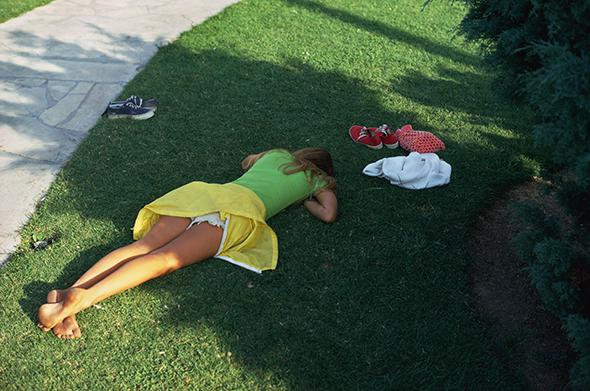A birth control pill with a glass of milk. This is what Howard Royal serves his daughter Rainey for breakfast every morning. He “waits until she swallows,” reminding her that “with maturity comes responsibility.” She is 14 years old.
Washing down a daily dose of womanhood with the wholesome drink of youth is the kind of contradiction that defines Rainey Royal, the title character in Dylan Landis’ second novel in stories. She’s old enough, and physically ripe in all the ways she needs to be, to make men “blush” and “stammer.” But she’s also young enough to wonder, when her father’s live-in best friend, Gordy, rubs her back at night, about “the place beneath a girl’s armpit that the back ends and the side begins.” Do “body parts meet clearly at dotted lines,” she asks herself, “like pink and green states on a gas-station map,” and has Gordy crossed a border he shouldn’t have?
In Rainey Royal, Landis explores the boundaries between sexual object and subject, victim and agent. It is Greenwich Village in the 1970s, and lines are blurry. Howard Royal is a jazz musician whose five-story townhouse is a revolving door for his acolytes, whom he invites into his home on account of both their musical prowess and their willingness to join him in the bedroom. Rainey’s mother, Linda Royal, has left for an ashram in Colorado, and Gordy has partly taken her place—brushing Rainey’s hair, for instance. But his nightly tuck-ins, long past the age at which a girl should be tucked in, are menacing and unwelcome. He and Howard share everything; before Linda left for the ashram, she “came and went from both bedrooms without embarrassment.”
Rainey, not surprisingly, is both intrigued and repulsed by sex. Howard calls his daughter a “centerfold,” and compares her figure to Sophia Loren’s. When she says, “Screw you,” he replies, “You can do better than your old dad.” At 13, Rainey is pinned down by Gordy in the bushes at Central Park, “the only time he lost control, and they still didn’t go all the way,” she tells us.
Rainey can’t decide if her sexuality is a powerful tool or a curse she’d just as soon be rid of, often feeling scandalized the moment her seduction achieves its desired result.
Sometimes, after standing too close, men remember the shine on her skin; they smell the tea-rose oil, and it drives them mad. And she wants to make them feel these things, and she wants to hold them off. It’s a delicate balance. It’s a constant calibration.
She loves how she and her friend Tina “can sit in certain ways and force certain male teachers to look at them.” But even as she intends to allure, she teeters between feelings of empowerment and guilt. When Gordy’s tucks-ins make her squirm, she feels “responsible for sending scent molecules through some primal part of his brain.”
The men in the book are almost all at least one part sinister and one part weak, and they reinforce Rainey’s sense of responsibility for the attention they lavish on her. Before Gordy nearly rapes her in the park, he says, “You radiate power and light,” as though she’s the one in control. Later, Damien, one of Howard’s acolytes, does rape Rainey, in her bedroom. Then he shrugs. “You patted your bed,” he says. “You did that thing with your eyes.” She runs to her father, and he similarly dismisses the charge, suggesting that “letting him in her room” could be “a ‘half yes.’ ”
What Rainey doesn’t fully understand, but what Landis gets completely, is the way that these experiences shape the young woman’s behavior outside of the castle-cum-prison that is her home. She tries to reclaim the power men have robbed her of, bullying girls, and even faculty, at school: When a chemistry teacher expresses concern about her home life, Rainey, hating that her vulnerability has been exposed, resolves to flirt with the teacher’s boyfriend, to show her who has the upper hand.

Courtesy of Lauren Shay Lavin
And Rainey seeks a substitute for the shelter her parents should have provided, soliciting the protection of St. Catherine of Bologna—or Cath, as she calls her, whose picture she tears from a library book and tucks into her backpack. Cath is the patron saint for artists and against temptation. “Rainey is an artist,” Landis writes, “and she embodies temptation.” She knows she’s more in need of protection from the temptation of others than from her own, and she’s envious that, “in the Cloister, Cath will never listen at night for the marquis padding toward her through chilled marble halls.” When they exhumed Cath’s body 18 days after her death, she was in pristine condition: “Undefiled by men, undefiled by death.”
Rainey’s struggle to be a subject instead of an object extends to her relationship with art. “Don’t try to understand jazz, Gordy said once: You are jazz.” But Rainey does not want to be jazz. Not when, on the floor of Gordy’s room, a cello “lies naked and bright.” Not when, after Damien rapes her, Howard protests, “Have you heard that boy play cornet? Have you listened?” She grew up on bebop instead of nursery rhymes, but there was always a hint of danger in its riffs, and so Rainey turns away from music to visual art. She makes tapestries out of the belongings of the dead. In the way she pieces together buttons and photographs, we see a girl longing for her mother, attempting to resurrect memories to endure her loss, as the losses of others stand in for her own.
Rainey Royal spans 11 years in just 246 pages, and the jumps in time can be abrupt. On one page, Rainey is 18, and on the next, she’s 23. And despite leapfrogging over half a decade, Rainey at 23 is almost indistinguishable from Rainey at 18. It’s not for lack of incident in her life: So much happens offstage it feels as though a chapter has been ripped cleanly from the binding. In later chapters, Landis shifts the narrative voice from Rainey to her friends Leah and Tina, making it even more difficult to grasp the extent of Rainey’s transformation. The novel-in-stories structure allows for a narrative looseness that more traditional novels tend not to get away with, but there were times when I longed for the tighter transitions that conventional form brings with it. The last story focuses on Tina’s relationship with Howard and spends little time on Rainey’s, and it feels like a detour away from our agreed-upon destination. (Those who want to fill in some of the stories’ gaps will be glad to know that Landis’ first collection, Normal People Don’t Live Like This, gives us more of Rainey and Tina and Leah, with the latter character coming to the fore.)
Still, the language Landis uses to get us there is transporting, sensual and musical by turns, appropriately enough for a book about sex and jazz. Now that I’ve seen a sandwich described as having a “petticoat of lettuce,” I will never look at BLTs the same. Leah, a victim of Rainey’s bullying—and Howard’s lustful gaze—is “the tottering lamb who cannot see the altar.” Touching the eyelids of an old man who has commissioned a tapestry, “her fingertips detect the darting motions of tiny fish.” And more than her often-stunning prose, it’s Landis’ exploration of teenage sexuality that sets her book apart. Landis sees the way that, as a girl lurches, sometimes too quickly, toward adulthood, sex can bleed into friendships and alter family dynamics, causing wounds and leaving scars. And Landis sees a way through it all as well: After Rainey’s grandmother refuses to let Rainey become trustee of the house her father has made unwelcoming, she tells her granddaughter, “a girl must always be her own trustee.” Rainey takes this as a mantra: “Be trustee of her own self. Be trustee of the house that is her person.” It is all—it is everything—a girl can hope to do.
—
Rainey Royal, by Dylan Landis. Soho Press.
See all the pieces in this month’s Slate Book Review.
Sign up for the Slate Book Review monthly newsletter.
